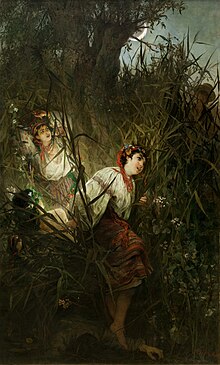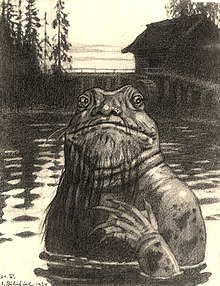Supernatural beings in Slavic religion
This article needs additional citations for verification. (March 2012) |

Other than the many
Vila

Vila (pl. vile, Slovak/Czech víly) is a fairy that is similar to a nymph, identified as a nymph by the Greek historian Procopius; their name comes from the same root as the name of Veles. They are described as beautiful, eternally young, dressed in white, with eyes flashing like thunders, and provided with wings, and blonde hair. They live in the clouds, in mountain woods or in the waters. They are well-disposed towards men, and can to turn themselves into horses, wolves, snakes, falcons and swans. The cult of the Vilas was still practised among South Slavs in the early twentieth century, with offerings of fruits and flowers in caves, cakes near wells, and ribbons hung from the branches of trees.[1]
Rusalka
In
Vodyanoy, Vodník

The
The vodyanoy lives in deep pools, often by a mill, and is said to be the spirit of unclean male dead (this definition includes those who have committed suicide, unbaptized children, and those who die without last rites). As previously stated, the vodyanoy would drown those who angered him with boasts or insults. However, there was no certain protection, as the spirit was particularly capricious. Peasants feared the vodyanoy and would often attempt to get rid of the spirit or, failing that, appease him.
The only people who were generally safe from the vodyanoy's anger were millers and fishermen. Millers in particular were viewed to be so close to the vodyanoy that they often became seen as sorcerous figures. This may be influenced by the belief that millers yearly drown a drunk passerby as an offering to the vodyanoy. Fishermen were somewhat less suspect, offering only the first of their catch with an incantation. If a vodyanoy favored a fisherman, he would herd fish into the nets.[3]
Bereginya
Bereginyas (
Boris Rybakov connects the term with the Slavic word for "riverbank" and reasons that the term referred to Slavic mermaids, although, unlike rusalkas, they were benevolent in nature.[4] The scholar identifies the worship of vampires and bereginyas as a form of "dualistic animism" practiced by the Slavs in the most ancient period of their history. According to him, the term was replaced by "rusalka" in most areas, surviving into the 20th century only in the Russian North. After the publication of Rybakov's research, the "bereginya" has become a popular concept with Slavic neo-pagans who conceive of it as a powerful pagan goddess rather than a mere water sprite.
Modern fiction
- The Winternight trilogy, by Katherine Arden, is inspired by Slavic mythology and includes many characters, such as the Domovoy, the Rusalka and other beings.
- In Edward Fallon's second book in his Linger series of novels, Trail of the Beast, a rusalka taunts a trio hunting a serial killer.
- C. J. Cherryh has written three novels, Rusalka, Chernevog and Yvgenie, set in a world inspired by Russian folktales that feature, amongst others, rusalka, vodyanoy, and leshy.
- In Changes, a novel in the Dresden Files series by Jim Butcher, the fairy Toot-Toot, a Polevoi, is enraged when he is mistakenly called a Domovoyby Sanya, the Russian Knight of the Cross.
- The videogame Quest For Glory IV: Shadows of Darkness, set in the Slavic countryside of a fictional east-European valley, features several Slavic fairies, including the Rusalka, Domovoy, and Leshy.
- Catherynne Valente's novel Deathless is set in a fantasy version of Stalinist Russiaand features vila, rusalka, leshy, and other Slavic fairies.
- Dorothy Dreyer's Reaper's Rite series depicts Vila as magical beings of half-faery, half-witch origin.
- In Fleur Delacour's grandmother was a Veela and Fleur's wand contains a strand of a veela hair.
- Piers Anthony's Xanth novels include a few Vily, as nature spirits bound to a tree (similar to a dryad) with powers of shapeshifting and cleansing or poisoning water, and extremely quick to anger.
- Andrzej Sapkowski's Wiedźmin series as well as the Witcher video games based on it are set in a medieval Slavic fantasy world. Many of the monsters are taken directly from or inspired by Slavic mythology, such as the rusalka, the striga, and the vodyanoi.
Mythical characters, spirits, and creatures
As is common in folklore, there is no standard set of characteristics, or names, and spirits or magical creatures are referred to by many names, often identifying their function or the place or environment of their activity. Such descriptive terms include:[citation needed]
- Bannik (banya, sauna)
- Bolotnik (swamp)
- Dvorovoy (yard, land)
- Leshy (forest)
- Sea Tsar (sea)
- Mermaid (sea)
- Moryana (Caspian Sea)
- Ovinnik (barn)
- Polevik (field in agriculture)
- The Mistress of the Copper Mountain (ore, Ural)
- Shubin (coal, Donbass)
- Vodyanoy (lake, river)
- Spirits of Atmosphere
- Moroz (mythology) (frost)
- Vedogon (spirit-guardian of a sleeping person)
- Vikhor (wind, whirlwind)
- Zduhać (protector from bad weather)
- Spirits of the time of day
- Babay(night)
- Poludnitsa (noon)
- Nocnitsa (night)
- Zorya (morning)
- Spirits of the sky
- Dennitsa (morning star)
- Veczernitsa (evening star)
- Spirit of Fate
- Dola(destiny fortune)
- Likho (misfortune)
- Narecnitsi, or Rodjenice, Sudjenice (parcae)
- Drekavac (nav of the South Slavs)
- Kikimora (harmful domestic female spirit)
- Mavka (evil spirits, rusalkas)
- Rusalka (the harmful spirit that appears in the summer in the grass field, in the forest, near the water)
- Samovila(a female spirit inhabiting the mountains and owning wells and lakes)
- Upyr(vampire)
- Devilry (evil power)
- Bies
- Chort
- Chuhaister
- Korov'ya smert' (Cow's death)
- Kallikantzaros
- Likhoradka
- Shishiga
- Zlydzens
- Ritual characters
- Berehynia(East Slavic mythology female character)
- Baba Marta (mythical female character in Bulgarian folklore, associated with the month of March. Martenitsa)
- Christmas holiday near the southern Slavs)
- Dodola(in the Balkan tradition, the spring-summer rite of causing rain, as well as the central character of this rite)
- German (ritual doll and the name of the rite of calling out rain of the southern Slavs)
- Jarilo(personification of one of the summer holidays in the Russian folk calendar)
- Koliada (the personification of the New Year's cycle)
- Kostroma (spring-summer ritual character in traditional Russian culture)
- Kupala (folklore character of the Eastern Slavs, the personification of the holiday of Kupala Night)
- Marzanna(the female mythological character associated with the seasonal rituals of dying and the resurrection of nature)
- Maslenitsa (folklore character of the Eastern Slavs, the personification of the holiday of Maslenitsa)
See also
- Mermaid
- Naiad
- Nix(or Nyx)
- Nymph
- Samodiva
- Water sprite
- Czech folklore
- Rusalka
References
- )
- ISBN 0-8153-035-4-8.
- ^ Ivanits, Linda. Russian Folk Belief. M.E. Sharpe, Inc: New York, 1989.
- ^ Boris Rybakov. Ancient Slavic Paganism. Moscow, 1981.
Further reading
- Linda Ivanits, Russian Folk Belief. Armonk, N.Y. and London: M.E. Sharpe, 1989.
- Власова, М. Новая абевега русских суеверий. Иллюстрированный словарь. Санкт Петербург: Северо-Запад. 1995
- Wilkinson, Philip Illustrated Dictionary of Mythology (1998)
- Зеленин, Дмитрий Константинович. Очерки русской мифологии: Умершие неестественною смертью и русалки. Москва: Индрик. 1995.
- Conrad, Joseph L. 2000. "Female Spirits Among the South Slavs". In: FOLKLORICA - Journal of the Slavic, East European, and Eurasian Folklore Association 5 (2): 27-34. https://doi.org/10.17161/folklorica.v5i2.3652.
- Conrad, Joseph L. 2001. "Male Mythological Beings Among the South Slavs". In: FOLKLORICA - Journal of the Slavic, East European, and Eurasian Folklore Association 6 (1): 3-9. https://doi.org/10.17161/folklorica.v6i1.3699.
- Radenković, Ljubinko. "South Slavic Folk Demonology Between East and West". In: Српска народна култура између Истока и Запада [Serbian Folk Culture between East and West]. Belgrade: Балканолошки институт Српске академије наука и уметности, 2014. pp. 9–42. ISBN 978-86-7179-086-4. (in Serbian)
